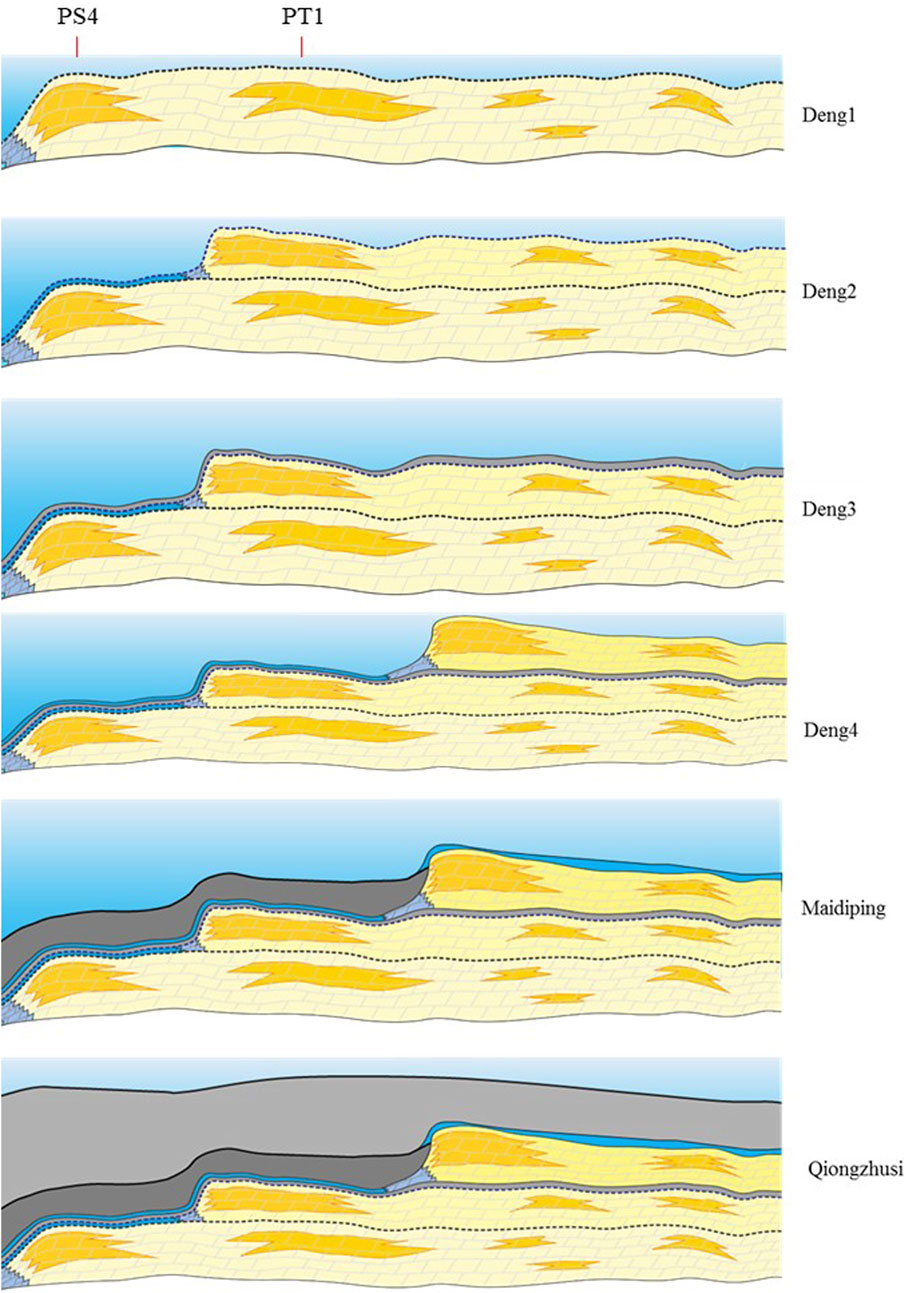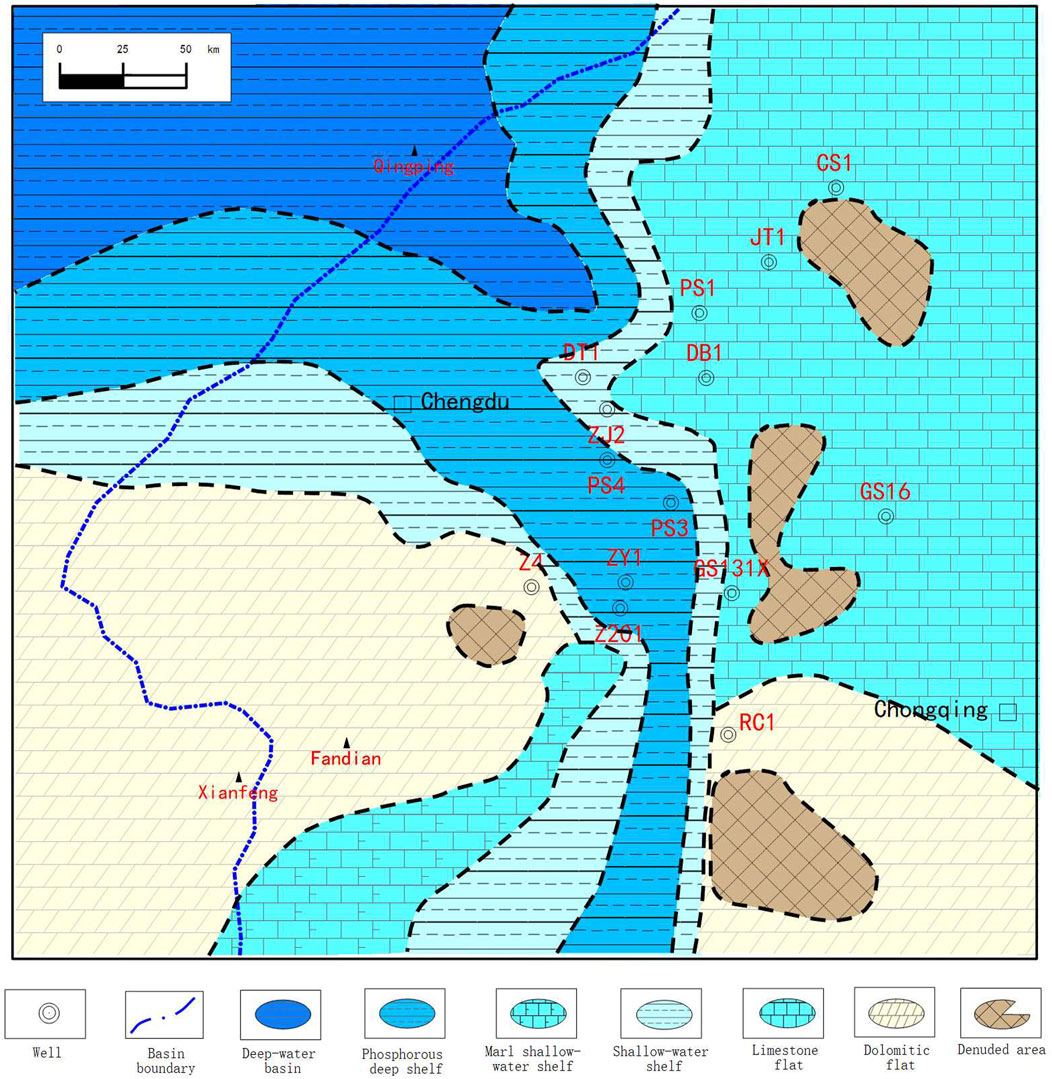- 1College of Energy, Chengdu University of Technology, Chengdu, China
- 2PetroChina Hangzhou Research Institute of Geology, Hangzhou, China
- 3PetroChina Southwest Oil and Gasfield Company, Chengdu, China
- 4Research Institute of Petroleum Exploration and Development, PetroChina, Beijing, China
- 5Nanjing Institute of Geology and Palaeontology, Chinese Academy of Sciences, Nanjing, China
The characteristics of elements, isotopes, and small shelly fossils were investigated for Late Ediacaran to Early Cambrian stratigraphy division and to discuss their geological implications in the northwestern Sichuan Basin. The results reveal that small shelly fossils can be detected in the high-phosphorous section, with the concentration of phosphorus mainly ranging from 2% to 8%, suggesting that this interval belongs to the Early Cambrian, which is also consistent with the carbon isotopic composition results. In addition, the Early Cambrian is denudated in the Sichuan Basin due to tectonic movement, and the characteristics of some isotopes and small shell fossils are different from those in other basins. It can be proposed that P content can support the recognition of lithological boundaries, and the high phosphorus content can be used as a reference to identify the top and bottom boundaries of the Maidiping Formation in the study area. According to the elemental compositions in the Ediacaran Dengying Formation, the variations in Si, Al, Fe, and K contents are similar in the platform area and rift area, suggesting that the third and fourth member of the Dengying Formation are also developed in the Deyang–Anyue Rift. The results suggest that both the Deng-4 member and Maidiping Formation feature contemporaneous deposition of different facies in the northwestern Sichuan Basin. The strata consist of shale intercalated with thin carbonate rock deposits in the Deyang–Anyue Rift, while carbonate rock deposits in the platform. The Deyang–Anyue Rift expanded gradually in the Late Ediacaran and eventually filled in the Early Cambrian. The data in this study illustrate that elemental compositions, isotopes, and small shelly fossils can be combined to correlate the Late Ediacaran to Early Cambrian strata and provide new evidence for Deyang–Anyue Rift evolution. The results offer some new insights for deep oil and gas exploration in the Sichuan Basin and for the tectonic–depositional–environmental–biological synergistic evolution in the Late Ediacaran to Early Cambrian transition.
1 Introduction
The Late Ediacaran to Early Cambrian interval is one of the most significant transitions in Earth history, involving life explosion (Darroch et al., 2018; Zhu et al., 2019; Darroch et al., 2021), supercontinent breakup (Feng et al., 2022a; Zhang et al., 2022a; Zhang et al., 2022b; Cutts et al., 2022), and marine redox changes (Chen et al., 2022; Liu et al., 2022). In addition, it is a crucial period for understanding life, tectonic, and environmental evolution on Earth. However, the stratigraphic correlation from Late Ediacaran to Early Cambrian is difficult and controversial (Yang et al., 2016; Landing and Kruse, 2017; Yang et al., 2017; Ding et al., 2021; Topper et al., 2022), and the lack of a high-resolution stratigraphic framework limits the investigation of the evolution of Earth and life (Shen and Schidlowski, 2000; Zhu et al., 2001; ZHU et al., 2009).
Previous studies suggested that the Early Cambrian is an important period for phosphorus formation in Earth’s history. The high enrichment of phosphorus indicates the special environment in the Early Cambrian and provides new insights for stratigraphic division (Cook and Shergold, 1984; Saltzman, 2005; Tsandev and Slomp, 2009; Shimura et al., 2014). Moreover, carbon isotopic composition has also been applied as a powerful tool for stratigraphic correlation, and δ13C values have significant negative shifts in the Ediacaran–Cambrian boundary across the globe (Lambert et al., 1987; Shen and Schidlowski, 2000; Jenkins et al., 2002; Maloof et al., 2010; Martin et al., 2011; Wang et al., 2012; Topper et al., 2022). Small shelly fossils (SSFs) occurred worldwide in the Early Cambrian, and they have significant potential for stratigraphic subdivision on old platforms, particularly for the pre-trilobitic Early Cambrian strata (Matthews and Missarzhevsky, 1975; Steiner et al., 2007; Coueffe and Vecoli, 2011; Creveling et al., 2013; Sato et al., 2014; Yang et al., 2016; Pan et al., 2022). In fact, the characteristics of phosphorus, carbon isotope, and small shelly fossils provide evidence for the special geological background during the Ediacaran–Cambrian transition. These anomalous phenomena are isochronous and can be combined to divide the Late Ediacaran to Early Cambrian strata.
The Sichuan Basin located in the Yangtze Platform is a favorable area to investigate geological events during the Ediacaran–Cambrian. However, the stratigraphic correlation of the Late Ediacaran to Early Cambrian is unclear, leading to the fact that the Deyang–Anyue Rift evolution in the northwestern Sichuan Basin is controversial, mainly due to the intracratonic rift (Li et al., 2018; Shen et al., 2020; Gao et al., 2021), extensional–erosional groove (Wang et al., 2014; Ding et al., 2021; Gu et al., 2021; Liu et al., 2021), eroded valley (Wen et al., 2014; Yang et al., 2014), and extensional sag (Li et al., 2015). The important question is whether the third and fourth members of the Dengying Formation are missing in the Deyang–Anyue Rift. On the other hand, the stratigraphic division of the Early Cambrian Maidiping Formation is also controversial. Some studies have shown that phosphorus-bearing dolomite should be developed in the Maidiping Formation based on the outcrop section in the Sichuan Basin (Feng et al., 2022b), but clastics were also developed in the Maidiping Formation according to the drill cores (Wang et al., 2021),. These results limit the study of lithofacies paleogeography (Shen et al., 2020; Lan et al., 2022; Pan et al., 2022). Thus, Late Ediacaran to Early Cambrian stratigraphic correlation in the Sichuan Basin requires further study.
In order to accurately determine the Ediacaran to Cambrian stratigraphic correlation, new methods were used to determine whether Deng-3 and Deng-4 are developed in the rifts, providing new evidence for the evolution of rifts. Here, we report the characteristics of phosphorus, isotopes, small shelly fossils, and other major elements from the Late Ediacaran to Early Cambrian in the northwestern Sichuan Basin. New geochemical and paleontological evidence was used for stratigraphic division of the Late Ediacaran to Early Cambrian stratigraphy. Furthermore, we discussed the formation and evolution of the Deyang–Anyue Rift, significance of hydrocarbon exploration in Dengying and Maidiping formations, and tectono–environmental–biological co-evolution from the late Ediacaran to Early Cambrian.
2 Geological setting
The Sichuan Basin is a superimposed basin developed on the Upper Yangtze Craton, with an area of approximately 1.8 × 105 km2. The crystalline basement of the Yangtze platform, after taking its shape, experienced a series of major geological events. Under the influence of the Rodinia supercontinent breakup in the Neoproterozoic era, the Xingkai taphrogenesis occurred in the Yangtze Paleocontinent in southern China (Liu et al., 2021; Zhao et al., 2021).
At the end of the regional continental rifting in the Ediacaran period, a craton basin had begun to evolve. Under the influence of regional tension, the Deyang–Anyue Rift extending from the ocean to the craton basin developed in the northwest Sichuan Basin. (Figure 1). The rift is 176 km long, 93 km wide at the widest point, and approximately 60 km wide at the narrowest point, with a near NW–SE strike (Wang et al., 2014; Yang et al., 2014). The faults are more developed near the rift and form scarps, which are steeper in the east and slower in the west. In addition, there are significant differences in strata and sediments between the rift and platform areas.
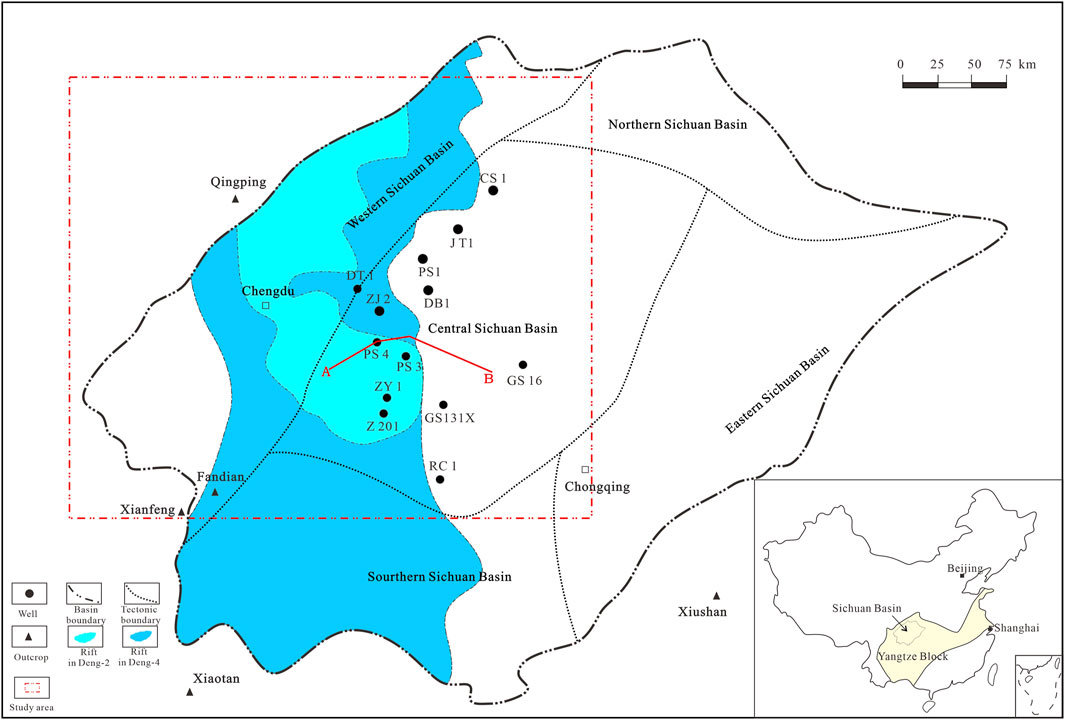
Figure 1. Sketch map showing geographical positions of the rift, drilling wells, and seismic section in theSichuan Basin (modified from Wei et al., 2015).
From the depositional stage of the Ediacaran Dengying to the Early Cambrian Meishucun stage, the Tongwan tectonic movement occurred in the Sichuan Basin, which was manifested as multi-stage uplifting and denudation, resulting in the weathered crust on the surface of unconformity. The previous studies have identified the three major episodes of the Tongwan tectonic movement: the end of the deposition of the Deng-2 member, that of the Deng-4 member, and that of the Maidiping Formation (Wang et al., 2014; Li et al., 2018; Gu et al., 2021; Wang et al., 2022). As the sea level increased rapidly during the depositional stage in the Early Cambrian, the Upper Yangtze Craton underwent a major change in the tectonic framework in the middle Early Cambrian, with the vertical differential movement significantly reduced in amplitude and the uplift–depression pattern beginning to vanish.
The Late Ediacaran to Early Cambrian strata in the Sichuan Basin mainly include the Ediacaran Dengying Formation, Early Cambrian Maidiping Formation, Qiongzhusi Formation, and Canglangpu Formation (Figure 2). The Ediacaran Dengying Formation is dominated by thick-bedded carbonate rock deposits and largely varies in thickness.
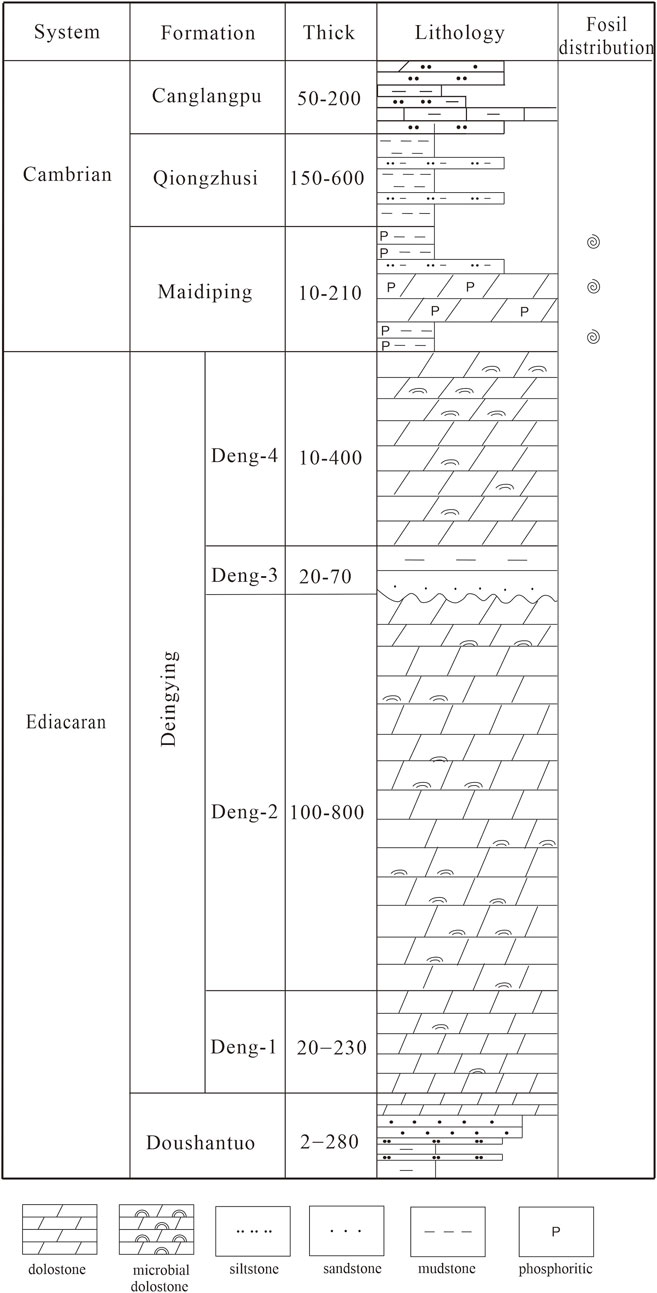
Figure 2. Late Ediacaran to Early Cambrian stratigraphic diagram for the Sichuan Basin (modified from Lan et al., 2022).
It has a large thickness at the platform area, mainly ranging from 500 m to 1,000 m, while a small thickness within the rift, mainly ranging from 200 m to 500 m. The Dengying Formation is divided into four members, and Deng-1–2, Deng-3, and Deng-4 correspond to Hamajing Member, Baimatuo Member, and Shibantan Member, respectively (Zhu et al., 2003). Petrologically, the Deng-1 and Deng-2 members are dominated by thick argillaceous dolostone and microbial dolostone, with similar features in the platform and rift areas. The Deng-3 member is mainly composed of mudstone and siltstone, with a relatively small thickness of 50 m, generally. The Deng-4 member is dominated by argillaceous dolostone in the platform area, which is similar to the Deng-2 member, but the lithology in the rift area is controversial. The Early Cambrian Maidiping Formation features contemporaneous deposition of different facies, specifically mudstone in the rift area and carbonate rock in the platform area. The Qiongzhusi Formation is mainly organic-rich mudstone.
3 Analytical methods
The current study was conducted based on the drilling logs of the Deyang–Anyue rift and platform areas in northwestern Sichuan Basin. The Ediacaran–Cambrian core and cutting samples were collected from the wells GS16, GS131X , and RC1 in the platform area and ZJ2, PS4, ZY1, and Z201 in the rift area. Elemental compositions, carbon isotope values, and small shelly fossils were investigated in this study to discuss the special geological background during the Ediacaran–Cambrian transition.
In order to analyze the elemental compositions such as Si, Al, Fe, K, and P, samples were analyzed following the Chinese standard Q/SY 1862-2016. Ten-gram rock samples were first crushed to a particle size below 0.1 mm. Then, the treated samples were excited by X-ray fluorescence, and the fluorescence signal was detected by using an EDX 5500H X-ray fluorescence spectrometer. The relative error was less than 5%.
For measuring the carbon isotopic compositions in this study, the crushed samples were treated with phosphoric acid, and the δ13C and δ18O values of the treated samples were determined by using a Finnigan MAT-253 mass spectrometer with the Kiel IV Carbonate Device. The test results of the δ13C and δ18O values were calculated following the international standards Pee Dee belemnite (PDB) and Standard Mean Ocean Water (SMOW), respectively. The error was kept below 0.1‰ against the Chinese national carbonate standard GBW04405.
Small shelly fossils were generally observed using thin sections and scanning electron microscopy. The treated samples were soaked in a 10% acetic acid solution, and small shelly fossils were picked out from 49 such samples using a LEICA microscope and stuck onto a microcolumn. After vacuum metalizing, the small shelly fossils were observed and imaged by using a Zeiss EVO 18 scanning electron microscope (SEM) to generate the SEM photographs at an acceleration voltage of 5–15 kV and a vacuum chamber pressure of 80–90 Pa and make the fossil plates. The entire analysis of small shelly fossils was conducted at Nanjing Institute of Geology and Paleontology, Chinese Academy of Sciences (NIGPAS, CAS).
4 Results
4.1 Petrological features
Based on outcrops, drilling cores, and thin sections, petrological features from the Late Ediacaran to Early Cambrian in the study area were investigated (Figure 3). In the second member of the Dengying Formation (Deng-2), argillaceous dolostone and microbial dolostone are dominant, and fibrous dolomite cement is shaped like a grape lace. The Deng-3 member is mainly composed of dark mudstone and siltstone, with some horizontal bedding sedimentary structures. The lithology from the Deng-4 member is similar to that of the Deng-2 member: mainly argillaceous dolostone and microbial dolostone, but without grape lace features. The Early Cambrian Maidiping Formation features contemporaneous deposition of different facies; in the rift area, phosphorus mudstone is mainly developed, whereas phosphorus dolomite and phosphorus limestone are mainly developed in the platform area.
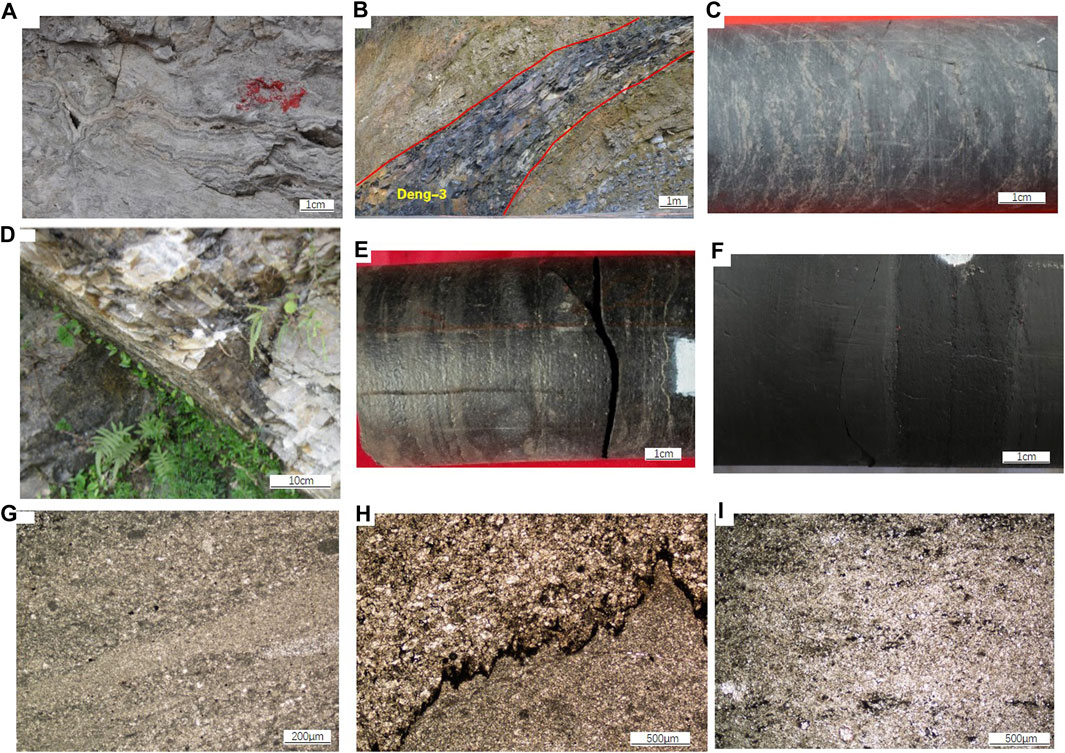
Figure 3. Photographs showing petrological features from Late Ediacaran to Early Cambrian in the Sichuan Basin: (A) Microbial dolostone in the second member of Dengying Formation from PS4, 6231.7 m, length-slow fibrous dolomite cement is shaped like grape lace, plane-polarized light (PPL). (B) Black-gray mudstone and micritic dolomite with horizontal bedding or wavy bedding, and the thickness of a single layer is less than 1 m in the Deng-3 member from Xiushan Outcrop. (C) Micritic dolostone in the Deng-4 member from Well MX51, 5375.62 m, core sample. (D) Phosphorus dolostone in Maidiping Formation from Fandian Outcrop. (E) Phosphorus dolostone in Maidiping Formation from Well RC1, 5406.52 m, core sample. (F) Organic-rich mudstone in Maidiping Formation from Well Z201, 4,888.21 m, core sample. (G) Micritic dolostone in Maidiping Formation from Well GS16, 5475.3 m, plane-polarized light (PPL). (H) Micritic dolostone in Maidiping Formation from Well GS16, 5462.7 m, PPL. (I) Micritic dolostone in Maidiping Formation from Well RC1, 5404.94 m, PPL.
4.2 Elemental composition
According to the analysis results of the elemental composition characteristics in different wells, a stratigraphic interval can always be found with a high phosphorus content, mainly ranging from 2% to 8% at the Ediacaran–Cambrian intersection in the wells at both the platform area (Figures 4, 5) and rift area (Figures 6–8). The other strata were found at a phosphorus content basically below 0.5%. In addition, the phosphorus content values are highest for the Z201 and ZJ2 (mainly ranging from 5% to 8%), followed by the GS131X and PS4 (mainly ranging from 3% to 5%), and lowest for the RC1 (average value closed to 2%), suggesting that the closer to the rift, the greater the phosphorus content values. The high phosphorus-bearing interval in the rift is thick, ranging from 50 m to 100 m, and is mainly composed of mudstone and marlstone, while that in the platform area is relatively thin, with a thickness of approximately 20 m, and dominated by dolomite or limestone.
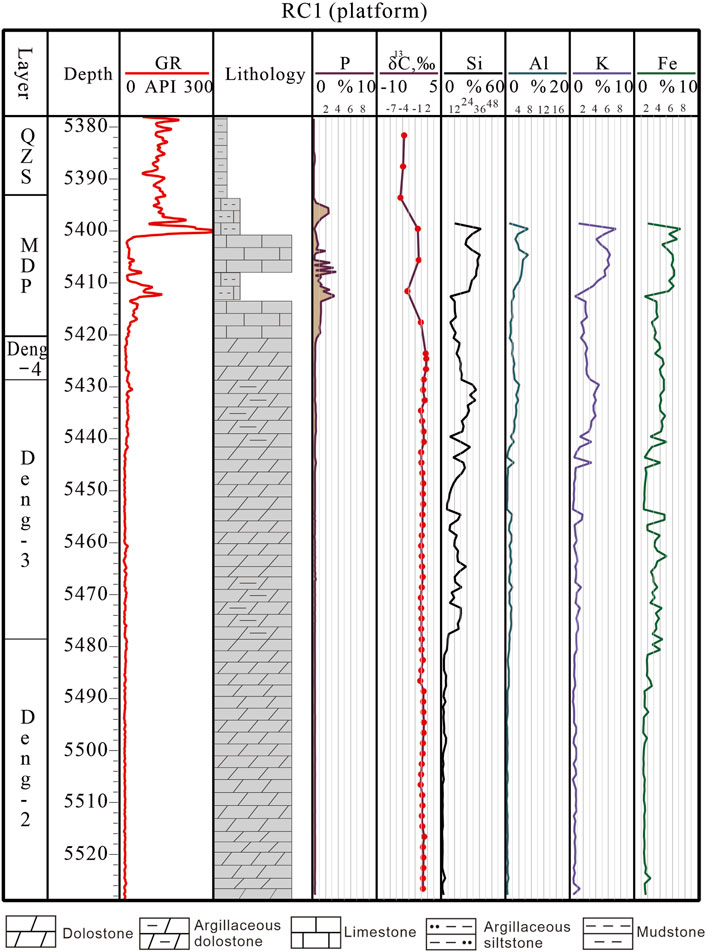
Figure 4. Elemental and carbon isotopic compositions from Late Ediacaran to Early Cambrian of the well RC1 in the platform area. (MDP, Maidiping Formation; QZS, Qiongzhusi Formation).

Figure 5. Elemental and carbon isotopic compositions from Late Ediacaran to Early Cambrian of the well GS137X in the platform area. (MDP, Maidiping Formation; QZS, Qiongzhusi Formation).

Figure 6. Elemental and carbon isotopic compositions from Late Ediacaran to Early Cambrian of the well PS4 in the rift area. (MDP , Maidiping Formation; QZS, Qiongzhusi Formation).

Figure 7. Elemental and carbon isotopic compositions from Late Ediacaran to Early Cambrian of the well Z201 in the rift area. (MDP, Maidiping Formation; QZS, Qiongzhusi Formation).
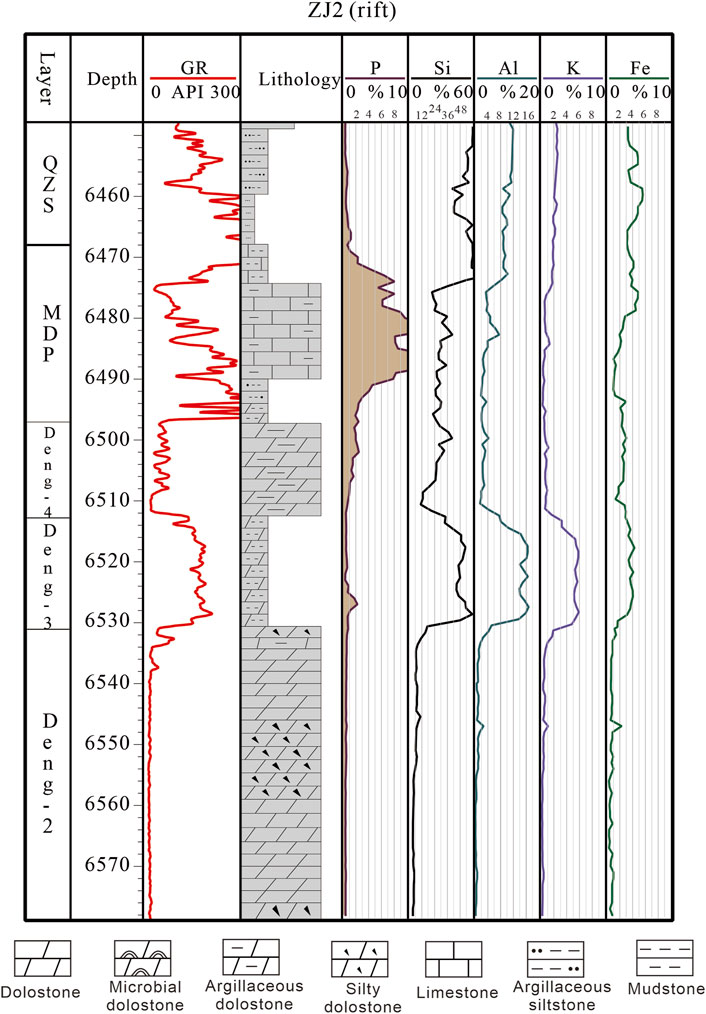
Figure 8. Elemental and carbon isotopic compositions from Late Ediacaran to Early Cambrian of the well ZJ2 in the rift area. (MDP, Maidiping Formation; QZS, Qiongzhusi Formation).
It can be seen from Figures 4–8 that the contents of Si, Al, Fe, and K are generally in consistent changes across different wells and different intervals in the rift and platform areas. Generally, the contents of Si, Al, Fe, and K increase with increasing provenance input and mainly reflect their inputs of provenance. By comparing the change characteristics of these four elements with the phosphorus content, it can be found that the contents of Si, Al, Fe, and K corresponding to a high phosphorus-containing interval are low. The Si content values mainly range from 10% to 30%, and the values of the other three element content are generally below 5%. When the phosphorus content decreases significantly at deeper positions, the corresponding contents of Si, Al, Fe, and K have no significant changes; the contents of elements Si, Al, Fe, and K obviously increase at a certain interval and then decrease with the further increase in depth. Such a change rule can be found in both the rift and platform areas. The previous studies were concluded on a basically consistent understanding of the Deng-3 member in the platform area on its stratigraphic division and as a deeper water environment mainly composed of mudstone (Wang et al., 2014; Yang et al., 2014; Shen et al., 2020). Based on the results of the current study, for example, in the well GS131X, the contents of Si, Al, Fe, and K elements in the Deng-3 member of the platform area are significantly high, reflecting its deeper water environment with abundant terrigenous clastics, while the contents of Si, Al, Fe, and K elements in Deng-2 and Deng-4 members are low. For the Deng-3 member of Gaoshi 131X, the Si, Al, Fe, and K content average values are close to 60%, 10%, 5%, and 4%, respectively.
It is worth noting that in the intervals with changes in the contents of Si, Al, Fe, and K elements in the rift, the corresponding phosphorus content was found to slightly increase, reaching approximately 2%, which is consistent with the previous conclusion on the phosphorus content increase in the period of the Dengying Formation (Cook and Shergold, 1984; Wang et al., 2022), reflecting the environmental changes during this period and providing evidence for the stratigraphic division based on the contents of Si, Al, Fe, and K elements.
4.3 Isotopic composition
According to the carbon isotope shifts in the study area, for the lower part of the high-phosphorus content interval, the carbon isotope values of the analyzed samples range from 1‰ to 3‰. However, the δ13C values vary significantly for the interval with high phosphorus content, mainly ranging from −5‰ to 5‰, and there is a negative carbon isotope shift across the boundary of high/low phosphorus content. In the top of the high phosphorus content interval, the δ13C values are complex, and the values in GS131X, RC1, and PS4 are approximately −4‰, −4‰ and 3‰, respectively.
4.4 Small shelly fossils
In this study, small shelly fossils were found in wells Z201, RC1, and GS16. In the well Z201, the depth of the high phosphorus-bearing interval is from 4,868.8 to 4,915.9 m, and the lithology is mainly mudstone and marlstone. Small shelly fossils were found in coring intervals at 4,868.9 m, 4883 m, 4870 m, 4,872.3 m, 4,872.48 m, 4,872.72 m, and 4,887.5 m. By comparison with the previously published literature (Steiner et al., 2007; Sato et al., 2014; Yang et al., 2016), it is indicated that the small shelly fossils of the well Z201 are dominated by molluscs, hyolithes, and siphogonuchites, among which hyolithes include Aegitellus emeishanensis and Cupitheca mira; molluscs include Eohalobia diandongensis and Ocruranus finial; and siphogonuchites include Siphogonuchites triangularis (Figure 9). This set of fossil assemblages is classified into the Early Cambrian fossil-lean zone between the second (the possible Paragloborilussubglobosus–Purella squamulosa assemblage zone) and the third (the Watsonella crosbyi assemblage zone) zones (Steiner et al., 2007; Yang et al., 2016; Steiner et al., 2020; Feng et al., 2022a).
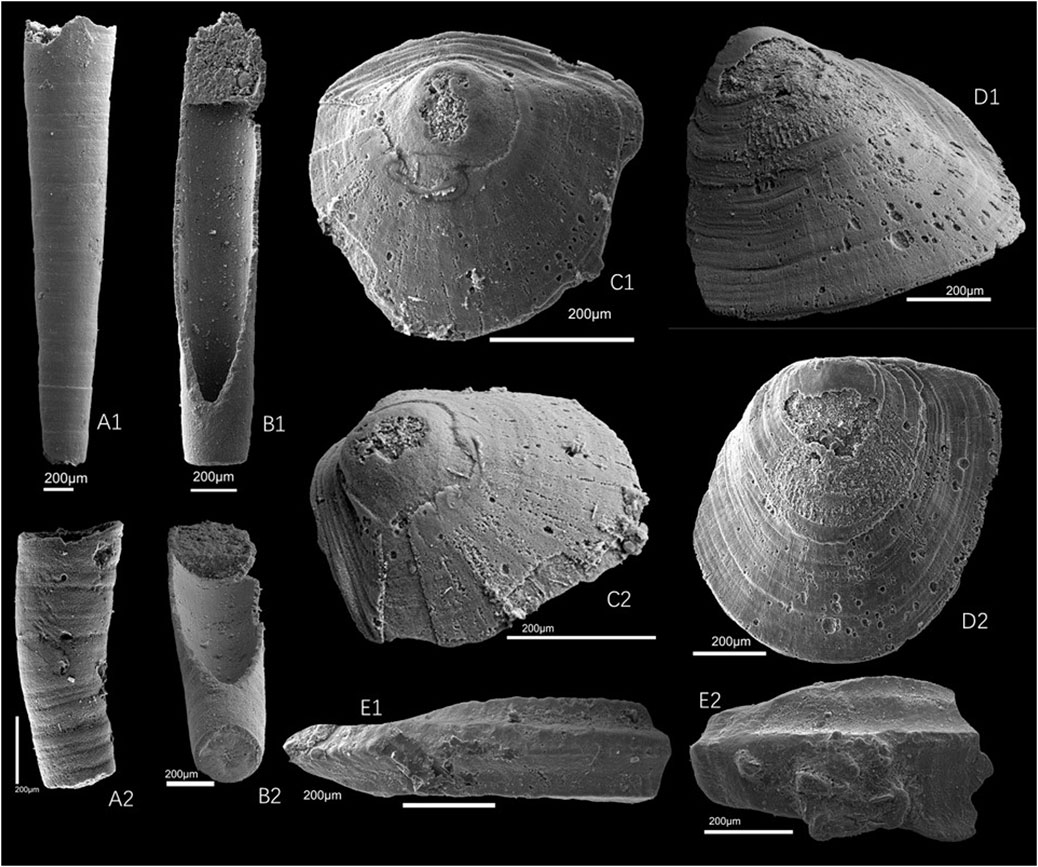
Figure 9. SEM micrographs of SSFs from Maidiping Formation in well Z201. (A) Aegitellus emeishanensis. (B) Cupitheca mira. (C) Eohalobia diandongensis. (D) Ocruranus finial. (E) Siphogonuchites triangularis.
The analysis in the well Gaoshi 16 was carried out in the limestone and dolomite from 5445 to 5478 m. Restricted due to the preservation conditions of fossils, a small number of small shelly fossils were observed in the rock slices, including hyolithes (Pseudovalitheca), siphogonuchites (Siphogonuchites), and mollusc (Eohalobia). This interval was accordingly classified into the Cambrian system. The phosphorous dolomite in the well RC 1 from 5404 to 5412 m was analyzed. The fossils were found to be mainly Siphogonuchites and Anabarites, which are all typical fossils in the Cambrian rather than Ediacaran.
The Late Ediacaran and Early Cambrian strata in the Fandian Outcrop section in the southern Sichuan Basin were continuously exposed and have been reported in previous studies (Li et al., 2013; Och et al., 2013). These results suggested that the Watsonella crosbyi assemblage zone is corresponding to the Zhujiaqing positive δ13Ccarb excursion (ZHUCE) in the Xiaotan Outcrop, and the bottom boundary is near the starting point of ZHUCE. In addition, the Sinosachites flagelliformis–Tannuolina zhangwentangi assemblage zone was also discovered in the Xiaotan Outcrop. The fossil and isotopic characteristics of Xiaotan Outcrop are consistent with those of the drilling well in this paper.
5 Discussion
5.1 Stratigraphic division
The lithologic and electrical properties of Late Ediacaran to Early Cambrian strata in the Sichuan Basin vary significantly. In the platform area, Deng-4 and Deng-2 members are mainly carbonates with lower gamma value, while the Deng-3 member is mudstone with a higher gamma value. Thus, stratigraphic division was mainly based on lithology in the previous studies, the boundary between dolomite and mudstone was used as the basis for division between the Ediacaran Dengying Formation and Cambrian Maidiping Formation, and correspondingly, the mudstone-developed overlaying thick-bedded dolomite in the rift was classified into Maidiping Formation (Shi et al., 2020; Lan et al., 2022). In the current study, the Qiongzhusi Formation was found to be obviously low phosphorus content, basically below 0.5%, while the top of the Maidiping Formation had high phosphorus content, ranging from 2% to 8%, so the change rules of the phosphorus content can be used to distinguish the Qiongzhusi and Maidiping formations. These two formations are also obviously different in terms of small shelly fossils, and no small shelly fossils were observed in the Qiongzhusi Formation. The Maidiping and Qiongzhusi formations are clearly bounded. The boundary between the Maidiping and Dengying formations, however, needs to be further identified, focusing on whether the underlying stratum of the phosphorus-bearing interval of the Maidiping Formation is classified into the Dengying Formation.
In the platform area, the carbonate rock is classified into the Dengying Formation and the overlying mudstone into the Qiongzhusi Formation. However, there are high phosphorus-bearing intervals at the top of the carbonate rock, with the content between 2% and 8% in the wells. Although the Ediacaran phosphorus-bearing intervals were previously found (Cook and Shergold, 1984; Sato et al., 2014), abundant small shelly fossils were also found from observations of the carbonate rock in these high phosphorus-bearing intervals, and previous studies demonstrated the occurrence of small shelly fossils as an important indication of the Cambrian system, and no such fossils have been found in the Ediacaran (Steiner et al., 2007; Yang et al., 2016). Therefore, the limestone or dolomite intervals with high phosphorus-bearing intervals from the platform area should be classified into the Cambrian instead of Dengying Formation. The carbon isotopic composition of the carbonate rock in the high phosphorus-bearing interval was found to be obviously more negative than that of the carbonate rock in the lower phosphorus-free interval, which is consistent with the negative shift characteristics of the carbon isotope in the Early Cambrian period and reflects the environmental changes. Thus, this stratum should be classified into the Maidiping Formation. There are obvious differences between the Maidiping and Dengying formations in terms of the phosphorus content, carbon isotopic composition, and characteristics of small shell fossils, reflecting the special geological setting of phosphating events, marine environmental changes, and surges of small shelly fossils in the Early Cambrian period. Under the influence of the Tongwan tectonic movement, the strata were denuded during the early and late deposition of the Maidiping Formation, resulting in the change rules of carbon isotopes and small shelly fossils different from those shown in the typical sections of the Early Cambrian. It is revealed that for the identification of lithological characteristics in drill cores, the P content can support the recognition of lithological boundaries, and the high phosphorus content can be used as a reference to identify the top and bottom boundaries of the Maidiping Formation in the study area.
Previous understandings of the stratigraphic division of Dengying Formation on the platform area are similar, and the Deng-4, Deng-2, and Deng-1 members are dominated by dolomite, while the Deng-3 member is dominated by mudstone and marlstone (Liu et al., 2021; Lan et al., 2022). In the platform area, such as GS131X and RC 1, as shown in Figure 4 and Figure 5, the Si, Al, K, and Fe elements contents of the Deng-3 member were found to be obviously higher than those of the Deng-4 and Deng-2 members, which is consistent with the change characteristics of the logging GR curves and reflects the changes of sedimentary environment and sources. With the abundant input of terrigenous clastics and deeper water, the Deng-3 member is high in Si, Al, K, and Fe contents. Thus, stratigraphic classification using elemental composition characteristics is feasible for the Dengying Formation.
In the rift area, the thick dolomite is thought to be a Deng-2 member, but whether the third and fourth members of the Dengying Formation are missing in the Deyang–Anyue Rift is controversial (Liu et al., 2021; Lan et al., 2022). The upper part of this thick dolomite is mainly clastic rock; small shell fossils and carbon isotope data are scarce. According to the phosphorus content variation, these clastic rocks can be divided into two sections. The upper part has high phosphorus content, and the lower part has low phosphorus content. As mentioned above, the significant increase in phosphorus content was an important feature of the Early Cambrian period. Thus, the upper part with clastic rocks and high phosphorus content correspond to the Maidiping Formation, while the lower part should be the Dengying Formation. In addition, the contents of Si, Al, K, and Fe elements are low in the thick dolomite interval in the rift area, which is consistent with the characteristics of the Deng-2 member. However, for the clastic rock interval with low phosphorus content, it can be divided into two parts according to the contents of Si, Al, K, and Fe. The contents of Si, Al, K, and Fe are high in the lower part, which is consistent with the characteristics of the Deng-3 member in the platform area, while the contents of Si, Al, K, and Fe are low in the upper part, which is consistent with the characteristics of the Deng-4 member. As a whole, the variations of sedimentary environment and provenance of the Dengying Formation in the rift area are consistent with those in the platform area; there are more terrigenous clastics for the Deng-3 member but less in Deng-2 and Deng-4 members. It is concluded that Deng-3 and Deng-4 members developed in the rift area.
According to the typical seismic section including rift and platform areas in the northwestern Sichuan Basin, the bottoms of Dengying, Qiongzhusi, and Maidiping formations can be identified (Figure 10). The seismic wave is continuous, showing the development of the Dengying Formation in the rift area.

Figure 10. Typical seismic profile in the northwestern Sichuan Basin showing the stratigraphic division; the location of seismic line is shown in Figure 1.
5.2 Deyang–Anyue Rift evolution
According to the analysis of the development characteristics of the Ediacaran–Cambrian strata in northwestern Sichuan, the Deng-3 and Deng-4 strata exist in the rift, and the phosphorus carbonate deposits developed in the platform area are classified into the Maidiping Formation. Both the Deng-4 member and Maidiping Formation feature contemporaneous deposition of different facies in northwestern Sichuan. The strata consist of deeper water shale intercalated with thin carbonate rock deposits in the rift and with carbonate rock deposits in the platform.
Under the tectonic background of the Rodinia continent breakup, a series of rift basins were formed due to the action of regional extension. At the end of the Ediacaran continental rift, the cratonic basin began to evolve, and Deyang–Anyue Rift developed within the carbonate platform and into a zonal rift of hundreds of meters in depth and tens of kilometers in width. As an intracratonic rift, the Deyang–Anyue rift can be divided into the following six evolution stages (Figure 11).
1. The depositional stage of the Deng-1 member features the development of a craton shallow-water platform. The platform area and rift area are similar in thickness and lithology.
2. In the depositional stage of the Deng-2 member, the intracraton rift began to develop with a smaller scale. The platform area is characterized by thick dolomite and the rift area by mixed deposits of terrigenous clastics and carbonate. At the end of this stage, strata uplift suffered denudation due to the Tongwan movement.
3. The depositional stage of the Deng-3 member features the initial transgression. The lithology is mainly dominated by mudstone and marlstone in both rift and platform areas.
4. The depositional stage of the Deng-4 member features the extension setting and rift development in the craton platform, shallow-water carbonate platform deposition with an average thickness of up to 500 m, and multistage mound–shoal complexes. Under the action of the regional extension, the ocean in western Sichuan extended toward the hinterland of the craton basin, resulting in the formation of the Deyang–Anyue Rift. The Deng-4 member in the rift was subject to deeper water deposition, and the settlement rate was greater than the deposition rate due to strong extension action. The stratum in the rift is thin and mainly composed of mixed siliciclastic–carbonate deposits, while the platform is composed of carbonate rock deposits. At the end of the deposition of the Deng-4 member, the strata were uplifted and denuded under the influence in the second episode of the Tongwan tectonic movement.
5. In the depositional stage of the Early Cambrian Maidiping Formation, the faults at the rift boundary in the craton were reactivated due to regional extension, and the sea water depth was slightly larger than that of the Deng-4 member period. At the end of the depositional stage of the Maidiping Formation, the strata were uplifted and denuded again under the influence in the third episode of the Tongwan tectonic movement. The platform area of the Maidiping Formation was developed with shallow-water phosphorus-bearing carbonate deposits, with a relatively small thickness of approximately 20 m on average, and the rift was dominated by phosphorus-bearing mudstone, with an average thickness of approximately 80 m.
6. In the depositional stage of the Qiongzhusi Formation, extension occurred again, and large-scale transgression happened, flooding the carbonate platform. Continental shelf facies clastic rocks were generally developed in northwestern Sichuan, and much of the source rock was developed in this stage in the Sichuan Basin. At the end of this depositional stage, the northwestern Sichuan area gradually transitioned into the shallow-water continental shelf facies, and the Deyang–Anyue Rift generally disappeared.
5.3 Hydrocarbon exploration potential
The evolution of Deyang–Anyue Rift is proposed on the basis of the analysis of the phosphorus contents, carbon isotopic compositions, and small shelly fossils in northwestern Sichuan from the Late Ediacaran to Early Cambrian. The Dengying Formation is characterized by contemporaneous difference facies in northwestern Sichuan and developed multi-stage sedimentary platform edge (Figure 12). Previous oil and gas exploration is mainly focused on the platform edge of the Deng-4 member (Lan et al., 2022; Zhu et al., 2022). However, the platform edge of the Deng-2 member is also developed, which is conducive to the development of high-quality reservoirs. Thus, the exploration field of Dengying Formation could be expanded.
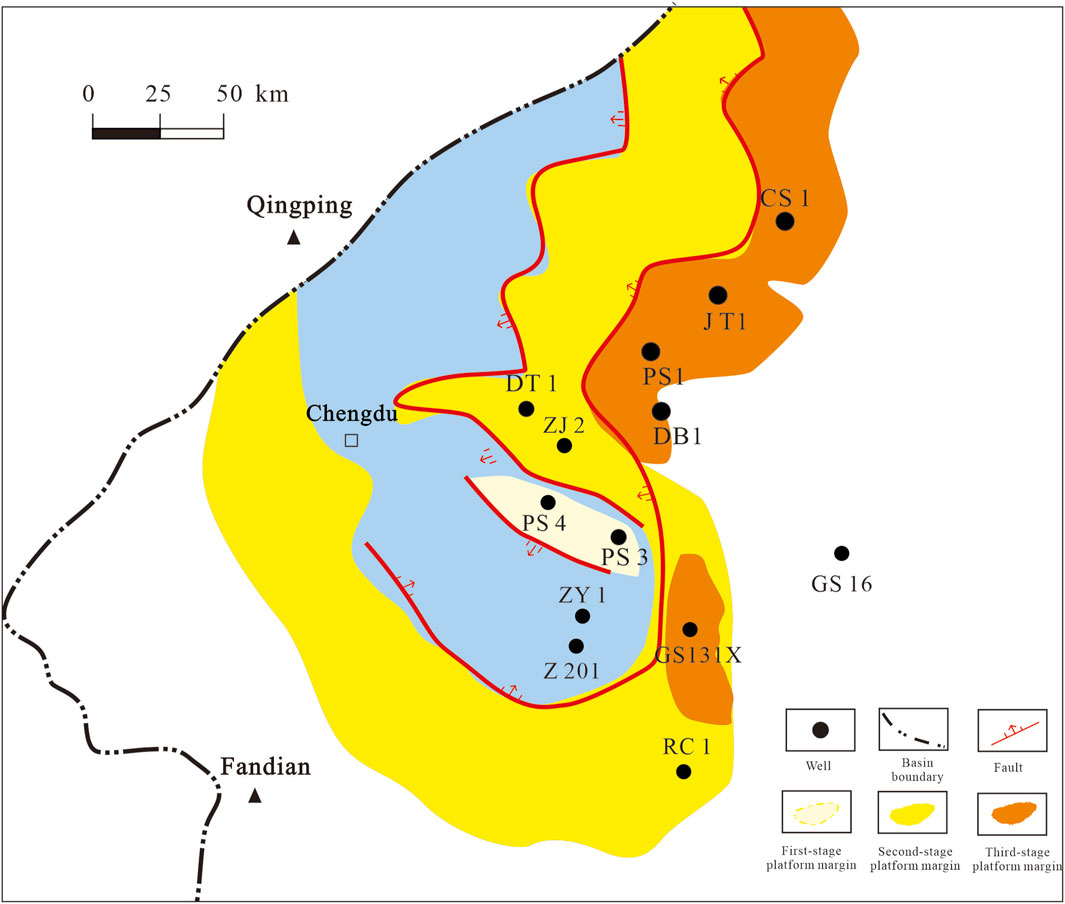
Figure 12. Platform edge distribution characteristics of Dengying Formation in northwestern Sichuan Basin.
Based on the stratigraphic correlation and well drilling data, lithofacies paleogeography of the Maidiping Formation was described (Figure 13). The rift area is dominated by phosphorous mudstone, which is characterized by deeper water. For the platform area, the northern part of Chongqing City is dominated by thin layers of phosphorous limestone. On the other hand, phosphorous dolomite can be found in the southern part of Chongqing City and most of the western Sichuan Basin area. The thickness of the dolomite mainly ranged from 30 to 80 m, and high-quality reservoirs can be developed.
The results demonstrate the favorable conditions created in the formation process of Deyang–Anyue Rift for hydrocarbon accumulation, two sets of high-quality source rock of the Maidiping and Qiongzhusi formations developed in the rift area, and large-scale high-quality reservoirs developed in the platform area. Thus, Late Ediacaran to Early Cambrian features in the northwestern Sichuan Basin have great hydrocarbon accumulation conditions and exploration potential.
5.4 Tectono–environment–biological co-evolution
Furthermore, the Ediacara–Cambrian transition is a large-scale deposition of global marine phosphorus. Previous studies suggested that an upwelling current contributed to the phosphate deposit (Shen et al., 2000; Creveling et al., 2013; Komar and Zeebe, 2017). According to the variation in phosphorus content, the value in the rift area is relatively higher than that in the platform area, and the phosphorus might migrate from the ocean. The result is consistent with that from upwelling currents, supporting the upwelling current model of phosphate deposit. Driven by upwelling currents, the phosphorus sea water flows over the carbonate platform from the rift. Phosphorus is an important factor in the prosperity of organisms. Phosphorus provides conditions for the prosperity of small shelly faunas and algae, and biochemistry plays an important role in phosphorus deposition at the same time (Komar and Zeebe, 2017; Schoellhorn et al., 2019). This also reflects the co-evolution relationship between the environment and organisms in the Ediacara–Cambrian transition.
The Ediacaran–Cambrian boundary has many carbon isotope excursion events, such as basal Cambrian negative δ13Ccarb excursion (BACE) and Zhujiaqing positive δ13Ccarb excursion (ZHUCE); Yangtze Platform, South China, has shown these phenomena (Lambert et al., 1987; Martin et al., 2011; Wang et al., 2012; Omidpour et al., 2021; Wang et al., 2021). However, in the study area, due to the Tongwan tectonic movement, the δ13Ccarb value characteristics in some areas are different from those in typical sections. In the platform area, δ13Ccarb values for the top of the Maidiping Formation in the well GS131X and RC1 are negative, suggesting that ZHUCE is missing. There are some differences from the typical stratum characteristics, which may be due to the tectonic evolution, and the strata are uplifted. According to the results presented in this study, it can also be proposed that carbon isotopic compositions of marine carbonates could provide a new reference for tectonic evolution, though δ13Ccarb values are commonly considered to apply for chemostratigraphic correlation. For instance, due to the denudation of strata caused by tectonic movement, the characteristics of carbon isotope composition are different from the typical profile.
6 Conclusion
Late Ediacaran to Early Cambrian stratigraphic correlation was discussed by investigating elements, isotopes, and small shelly fossil characteristics. The Maidiping Formation is characterized by high phosphorus content ranging from 2% to 8%, and it can be used to distinguish the Qiongzhusi/Maidiping boundary and Maidiping/Dengying boundary. According to the variation of Si, Al, Fe, and K elemental contents in the Dengying Formation, the third and fourth member of the Dengying Formation are also developed in the Deyang–Anyue Rift. The strata consist of deeper water shale intercalated with thin carbonate rock deposits in the Deyang–Anyue Rift, with carbonate rock deposits in the platform.
Deyang–Anyue Rift expanded gradually in the Late Ediacaran Dengying stage, eventually filled in the Early Cambrian Canglangpu stage, and the Maidiping–Qiongzhusi stage was the peak of the Deyang–Anyue Rift. The results demonstrate the favorable conditions created in the formation process of the Deyang–Anyue Rift for hydrocarbon accumulation: two sets of high-quality source rock of the Maidiping and Qiongzhusi formations developed in the rift area and large-scale high-quality reservoirs developed in the platform area.
The Late Ediacaran to Early Cambrian interval is a crucial transition in Earth’s history; thus, elemental compositions, particularly phosphorus, carbon isotopic composition, and small shelly fossils are special, and they can be combined to investigate the geological events of the Late Ediacaran to Early Cambrian. This study presents the synergistic evolution of tectonic–deposition–environment–biology from the Late Ediacaran to Early Cambrian and provides a new idea for the understanding of such a transition period.
Data availability statement
The original contributions presented in the study are included in the article/supplementary material; further inquiries can be directed to the corresponding authors.
Author contributions
WL: conceptualization, investigation, methodology, visualization, writing–original draft, writing–review and editing, and funding acquisition. JZ: investigation, writing–review and editing, conceptualization, project administration, and resources. XZ: investigation, methodology, visualization, and writing–review and editing. YW: investigation, methodology, and visualization, and writing–review and editing. XT: investigation, resources, project administration, and writing–review and editing. XF: methodology, investigation, conceptualization, and writing–review and editing. HJ: investigation, methodology, visualization, and writing–review and editing. YZ: investigation, resources, project administration, and writing–review and editing. SL: investigation, methodology, and writing–review and editing. RL: investigation, methodology, visualization, and writing–review and editing. BP: investigation, methodology, resources, and writing–review and editing. BD: investigation, methodology, and writing–review and editing.
Funding
The author(s) declare that financial support was received for the research, authorship, and/or publication of this article. The study is funded by the the Science and Technology Major Project of PetroChina (Grant No. 2023ZZ16YJ01), and the Fundamental Forward-looking Major Project of PetroChina (Grant No. 2023ZZ02).
Acknowledgments
The authors are grateful to PetroChina Southwest Oil and Gasfield Company for supplying the samples and providing original geological data. The authors also appreciate the editor and reviewers for their instructive comments which significantly improved the initial manuscript.
Conflict of interest
Authors XT and YZ were employed by PetroChina Southwest Oil and Gasfield Company. Authors HJ and RL were employed by PetroChina.
The remaining authors declare that the research was conducted in the absence of any commercial or financial relationships that could be construed as a potential conflict of interest.
Publisher’s note
All claims expressed in this article are solely those of the authors and do not necessarily represent those of their affiliated organizations, or those of the publisher, the editors, and the reviewers. Any product that may be evaluated in this article, or claim that may be made by its manufacturer, is not guaranteed or endorsed by the publisher.
References
Chen, Z., Wang, G., and Jin, C. (2022). Marine redox variation and hydrographic restriction in the early Cambrian Nanhua Basin, South China. Palaeogeogr. Palaeoclimatol. Palaeoecol. 607, 111263. doi:10.1016/j.palaeo.2022.111263
Cook, P. J., and Shergold, J. H. (1984). Phosphorus, phosphorites and skeletal evolution at the Precambrian-Cambrian Boundary. Nature 308 (15), 231–236. doi:10.1038/308231a0
Coueffe, R., and Vecoli, M. (2011). New sedimentological and biostratigraphic data in the Kwahu Group (Meso-to Neoproterozoic), southern margin of the Volta Basin, Ghana; stratigraphic constraints and implications on regional lithostratigraphic correlations. Precambrian Res. 189 (1-2), 155–175. doi:10.1016/j.precamres.2011.05.009
Creveling, J. R., Johnston, D. T., Poulton, S. W., Kotrc, B., Marz, C., Schrag, D. P., et al. (2013). Phosphorus sources for phosphatic Cambrian carbonates. Geol. Soc. Am. Bull. 126 (1-2), 145–163. doi:10.1130/b30819.1
Cutts, K., Schannor, M., Moreira, H., and Roberts, N. M. W. (2022). The Dynamic Neoproterozoic Evolution of eastern Brazil: crustal evolution, supercontinent assembly and breakup. Precambrian Res. 379106805, 106805. doi:10.1016/j.precamres.2022.106805
Darroch, S. A. F., Cribb, A. T., Buatois, L. A., Germs, G. J. B., Kenchington, C. G., Smith, E. F., et al. (2021). The trace fossil record of the Nama Group, Namibia: exploring the terminal Ediacaran roots of the Cambrian explosion. Earth-Science Rev. 212103435, 103435. doi:10.1016/j.earscirev.2020.103435
Darroch, S. A. F., Smith, E. F., Laflamme, M., and Erwin, D. H. (2018). Ediacaran extinction and cambrian explosion. Trends Ecol. Evol. 33 (9), 653–663. doi:10.1016/j.tree.2018.06.003
Ding, Y., Li, Z., Liu, S., Song, J., Zhou, X., Sun, W., et al. (2021). Sequence stratigraphy and tectono-depositional evolution of a late Ediacaran epeiric platform in the upper Yangtze area, South China. Precambrian Res. 354106077, 106077. doi:10.1016/j.precamres.2020.106077
Feng, Q., Pan, B., Yang, A., Lu, M., and Li, G. (2022a). Biostratigraphy of the small shelly fossils from the upper Maidiping Formation (terreneuvian) at the fandian section, sichuan province, south China. Front. earth Sci. (Lausanne) 10. doi:10.3389/feart.2022.922439
Feng, Z., Zhang, Q., Liu, Y., Li, L., Jiang, L., Zhou, J., et al. (2022b). Reconstruction of Rodinia supercontinent: evidence from the erguna block (NE China) and adjacent units in the eastern central asian orogenic belt. Precambrian Res. 368106467, 106467. doi:10.1016/j.precamres.2021.106467
Gao, P., Li, S., Lash, G. G., Yan, D., Zhou, Q., and Xiao, X. (2021). Stratigraphic framework, redox history, and organic matter accumulation of an Early Cambrian intraplatfrom basin on the Yangtze Platform, South China. Mar. petroleum Geol. 130105095, 105095. doi:10.1016/j.marpetgeo.2021.105095
Gu, Z., Lonergan, L., Zhai, X., Zhang, B., and Lu, W. (2021). The formation of the Sichuan Basin, south China, during the late ediacaran to early cambrian. Basin Res. 33 (4), 2328–2357. doi:10.1111/bre.12559
Jenkins, R. J. F., Cooper, J. A., and Compston, W. (2002). Age and biostratigraphy of Early Cambrian tuffs from SE Australia and southern China. J. Geol. Soc. 159 (6), 645–658. doi:10.1144/0016-764901-127
Komar, N., and Zeebe, R. E. (2017). Redox-controlled carbon and phosphorus burial: a mechanism for enhanced organic carbon sequestration during the PETM. Earth Planet. Sci. Lett. 47971-82, 71–82. doi:10.1016/j.epsl.2017.09.011
Lambert, I. B., Walter, M. R., Wenlong, Z., Songnian, L., and Guogan, M. (1987). Palaeoenvironment and carbon isotope stratigraphy of upper proterozoic carbonates of the Yangtze platform. Nature 325 (6100), 140–142. doi:10.1038/325140a0
Lan, C., Xu, Z., Yang, D., Yang, W., Lu, C., Chen, H., et al. (2022). Stratigraphy and depositional evolution of the terminal Ediacaran platform in the central to northern Sichuan Basin, Southwest China. Palaeogeogr. Palaeoclimatol. Palaeoecol. 601111142, 111142. doi:10.1016/j.palaeo.2022.111142
Landing, E., and Kruse, P. D. (2017). Integrated stratigraphic, geochemical, and paleontological late Ediacaran to early Cambrian records from southwestern Mongolia: comment. Geol. Soc. Am. Bull. 129 (7-8), 1012–1015. doi:10.1130/b31640.1
Li, D., Ling, H., Shields-Zhou, G. A., Chen, X., Cremonese, L., Och, L., et al. (2013). Carbon and strontium isotope evolution of seawater across the ediacaran–cambrian transition: evidence from the xiaotan section, NE yunnan, south China. Precambrian Res. 225128-147, 128–147. doi:10.1016/j.precamres.2012.01.002
Li, S., Gao, P., Huang, B., Wang, H., and Wo, Y. (2018). Sedimentary constraints on the tectonic evolution of Mianyang-Changning trough in the Sichuan Basin. OIL GAS Geol. 39 (05), 889–898.
Liu, S., Yang, Y., Deng, B., Zhong, Y., Wen, L., Sun, W., et al. (2021). Tectonic evolution of the Sichuan Basin, southwest China. Earth-Science Rev. 213103470, 103470. doi:10.1016/j.earscirev.2020.103470
Liu, Y., Ding, W., Lang, X., Xing, C., Wang, R., Huang, K., et al. (2022). Refining the early Cambrian marine redox profile by using pyrite sulfur and iron isotopes. Glob. Planet. Change 213103817, 103817. doi:10.1016/j.gloplacha.2022.103817
Li, W., Liu, J. J., Deng, S. H., Zhang, B. M., and Zhou, H. (2015). The nature and role of Late Sinian-Early Cambrian tectonic movement in Sichuan Basin and its adjacent areas. Acta Pet. Sin. 36 (5), 546–556.
Maloof, A. C., Ramezani, J., Bowring, S. A., Fike, D. A., Porter, S. M., and Mazouad, M. (2010). Constraints on Early Cambrian carbon cycling from the duration of the Nemakit-Daldynian-Tommotian boundary δ13C shift, Morocco. Geology 38 (7), 623–626. doi:10.1130/g30726.1
Martin, A. J., Burgy, K. D., Kaufman, A. J., and Gehrels, G. E. (2011). Stratigraphic and tectonic implications of field and isotopic constraints on depositional ages of Proterozoic Lesser Himalayan rocks in central Nepal. Precambrian Res. 185 (1-2), 1–17. doi:10.1016/j.precamres.2010.11.003
Matthews, S. C., and Missarzhevsky, V. V. (1975) Small shelly fossils of late Precambrian and Early Cambrian age: a review of recent work. J. Geol. Soc. Lond. 131289-304, 289–303. doi:10.1144/gsjgs.131.3.0289
Och, L. M., Shields-Zhou, G. A., Poulton, S. W., Manning, C., Thirlwall, M. F., Li, D., et al. (2013). Redox changes in early cambrian black shales at xiaotan section, yunnan province, south China. Precambrian Res. 225166-189, 166–189. doi:10.1016/j.precamres.2011.10.005
Omidpour, A., Moussavi-Harami, R., Mahboubi, A., and Rahimpour-Bonab, H. (2021). Application of stable isotopes, trace elements and spectral gamma-ray log in resolving high-frequency stratigraphic sequences of a mixed carbonate-siliciclastic reservoirs. Mar. petroleum Geol. 125104854, 104854. doi:10.1016/j.marpetgeo.2020.104854
Pan, X., Xiong, L., Dai, Q., Luo, J., Liu, Z., Wang, T., et al. (2022). Phosphatized obruchevella and other microfossils from the ediacaran-cambrian transition, southern sichuan province, China. Precambrian Res. 380106825. doi:10.1016/j.precamres.2022.106825
Saltzman, M. R. (2005). Phosphorus, nitrogen, and the redox evolution of the Paleozoic oceans. Geol. (Boulder) 33 (7), 573–576. doi:10.1130/g21535.1
Sato, T., Isozaki, Y., Hitachi, T., and Shu, D. (2014). A unique condition for early diversification of small shelly fossils in the lowermost Cambrian in Chengjiang, South China: enrichment of phosphorus in restricted embayments. Gondwana Res. 25 (3), 1139–1152. doi:10.1016/j.gr.2013.07.010
Schoellhorn, I., Houben, A., Gertsch, B., Adatte, T., Ulianov, A., de Kaenel, E., et al. (2019). Enhanced upwelling and phosphorite formation in the northeastern Pacific during the late Oligocene; depositional mechanisms, environmental conditions, and the impact of glacio-eustacy. Geol. Soc. Am. Bull. 132 (3-4), 687–709. doi:10.1130/b32061.1
Shen, A., Chen, Y., Zhang, J., Ni, X., Zhou, J., and Wu, X. (2020). Characteristics of intra-platform rift in ancient small-scalecratonic platform of China and its implications for hydrocarbon exploration. OIL GAS Geol. 41 (01), 15–25.
Shen, Y., and Schidlowski, M. (2000). New C isotope stratigraphy from southwest China: implications for the placement of the Precambrian-Cambrian boundary on the Yangtze Platform and global correlations. Geology 28 (7), 623–626. doi:10.1130/0091-7613(2000)028<0623:ncisfs>2.3.co;2
Shen, Y., Schidlowski, M., and Chu, X. (2000). Biogeochemical approach to understanding phosphogenic events of the terminal Proterozoic to Cambrian. Palaeogeogr. Palaeoclimatol. Palaeoecol. 158 (1), 99–108. doi:10.1016/s0031-0182(00)00033-x
Shi, C., Cao, J., Luo, B., Hu, W., Tan, X., and Tian, X. (2020). Major elements trace hydrocarbon sources in over-mature petroleum systems; insights from the Sinian Sichuan Basin, China. Precambrian Res. 343105726, 105726. doi:10.1016/j.precamres.2020.105726
Shimura, T., Kon, Y., Sawaki, Y., Hirata, T., Jian, H., Degan, S., et al. (2014). In-situ analyses of phosphorus contents of carbonate minerals; reconstruction of phosphorus contents of seawater from the Ediacaran to Early Cambrian. Gondwana Res. 25 (3), 1090–1107. doi:10.1016/j.gr.2013.08.001
Steiner, M., Ben, Y., Hohl, S., Lei, Z., and Shan, C. (2020). Cambrian small skeletal fossil and carbon isotope records of the southern Huangling Anticline, Hubei (China) and implications for chemostratigraphy of the Yangtze Platform. Palaeogeogr. Palaeoclimatol. Palaeoecol. 554109817. doi:10.1016/j.palaeo.2020.109817
Steiner, M., Li, G., Qian, Y., Zhu, M., and Erdtmann, B. (2007). Neoproterozoic to Early Cambrian small shelly fossil assemblages and a revised biostratigraphic correlation of the Yangtze Platform (China). Palaeogeogr. Palaeoclimatol. Palaeoecol. 254 (1), 67–99. doi:10.1016/j.palaeo.2007.03.046
Topper, T., Betts, M. J., Dorjnamjaa, D., Li, G., Li, L., Altanshagai, G., et al. (2022). Locating the BACE of the cambrian: bayan gol in southwestern Mongolia and global correlation of the ediacaran–cambrian boundary. Earth-science Rev. 229104017, 104017. doi:10.1016/j.earscirev.2022.104017
Tsandev, I., and Slomp, C. P. (2009). Modeling phosphorus cycling and carbon burial during cretaceous oceanic anoxic events. Earth Planet. Sci. Lett. 286 (1), 71–79. doi:10.1016/j.epsl.2009.06.016
Wang, H., Liu, S., Hou, M., Zhang, B., Song, J., Zhao, R., et al. (2022). Petrological and micrometer-scale geochemical constraints on chert origins in the Dengying Formation, Yangtze Block, south China; implications for Late Ediacaran hydrothermal activity and tectonic setting. Precambrian Res. 370106531, 106531. doi:10.1016/j.precamres.2021.106531
Wang, N., Wen, L., Li, M., Dai, X., Xu, Y., Ming, Y., et al. (2021). The origin of abnormally 13C-depleted organic carbon isotope signatures in the early Cambrian Yangtze Platform. Mar. petroleum Geol. 128105051, 105051. doi:10.1016/j.marpetgeo.2021.105051
Wang, W., Zhou, C., Yuan, X., Chen, Z., and Xiao, S. (2012). A pronounced negative δ13C excursion in an Ediacaran succession of western Yangtze Platform: a possible equivalent to the Shuram event and its implication for chemostratigraphic correlation in South China. Gondwana Res. 22 (3-4), 1091–1101. doi:10.1016/j.gr.2012.02.017
Wang, Z., Jiang, H., Wang, T., Lu, W., Gu, Z., Xu, A., et al. (2014). Paleo-geomorphology formed during Tongwan tectonization in Sichuan Basin and its significance for hydrocarbon accumulation. PETROLEUM Explor. Dev. 41 (03), 338–345. doi:10.1016/s1876-3804(14)60038-0
Wen, L., Yang, Y. M., You, C. Q., Zhang, X. H., Peng, H. L., Wang, W. Z., et al. (2014). Characteristics of Dengying Fm sedimentary sequence in the central-western Sichuan Basin and their controlling effect on gas accumulation. Nat. Gas. Ind. 36 (7), 8–17.
Yang, B., Steiner, M., Zhu, M., Li, G., Liu, J., and Liu, P. (2016). Transitional Ediacaran–Cambrian small skeletal fossil assemblages from South China and Kazakhstan: implications for chronostratigraphy and metazoan evolution. Precambrian Res. 285202-215, 202–215. doi:10.1016/j.precamres.2016.09.016
Yang, C., Zhu, M., Condon, D. J., and Li, X. (2017). Geochronological constraints on stratigraphic correlation and oceanic oxygenation in Ediacaran-Cambrian transition in South China. J. Asian Earth Sci. 140, 14075–14081. doi:10.1016/j.jseaes.2017.03.017
Yang, Y., Huang, X. P., Zhang, J., Yang, G., Song, J. R., Song, L. K., et al. (2014). Features and geologic significances of the top Sinian krast landform before the Cambrian deposition in the Sichuan Basin. Nat. Gas. Ind. 34 (3), 38–43.
Zhang, J., Pandit, M. K., Chen, W. T., and Wang, W. (2022a). Tonian and cryogenian – early cambrian sedimentation in NW India: implications on the transition from Rodinia to gondwana. J. Asian Earth Sci. 229105171, 105171. doi:10.1016/j.jseaes.2022.105171
Zhang, L., Wang, Z., Xu, B., Zou, H., Zhao, P., and Zhang, H. (2022b). Neoproterozoic–early cambrian igneous and sedimentary sequences in the songliao block, NE China: records of Rodinia supercontinent evolution in eastern central asian orogenic belt. Precambrian Res. 381106865, 106865. doi:10.1016/j.precamres.2022.106865
Zhao, B., Long, X., Luo, J., Dong, Y., Lan, C., Wang, J., et al. (2021). Late Neoproterozoic to early Paleozoic paleogeographic position of the Yangtze Block and the change of tectonic setting in its northwestern margin; evidence from detrital zircon U-Pb ages and Hf isotopes of sedimentary rocks. Geol. Soc. Am. Bull. 134 (1-2), 335–347. doi:10.1130/b35980.1
Zhu, M. Y., Yang, A. H., Yuan, J. L., Li, G. X., Zhang, J. M., Zhao, F. C., et al. (2019). Cambrian integrative stratigraphy and timescale of China. Sci. China Earth Sci. 62, 6225–6260. doi:10.1007/s11430-017-9291-0
Zhu, L., Liu, G., Song, Z., Zhao, W., Li, Q., Tian, X., et al. (2022). Reservoir solid bitumen-source rock correlation using the trace and rare earth elements–implications for identifying the natural gas source of the Ediacaran-Lower Cambrian reservoirs, central Sichuan Basin. Mar. petroleum Geol. 137105499, 105499. doi:10.1016/j.marpetgeo.2021.105499
Zhu, M., Li, G., and Zhang, J. (2001). New C isotope stratigraphy from southwest China: implications for the placement of the precambrian- cambrian boundary on the Yangtze platform and global correlations: comment and reply. Geology 29 (9), 871–872. doi:10.1130/0091-7613(2001)029<0871:ncisfs>2.0.co;2
Zhu, M., Zhang, J., Steiner, M., Yang, A., Li, G., and Erdtmann, B. (2003). Sinian-Cambrian stratigraphic framework for shallow-to deep-water environments of the Yangtze Platform: an integrated approach. Prog. Nat. Sci. 13 (12), 951–960. doi:10.1080/10020070312331344710
Keywords: phosphorus, small shelly fossil, stratigraphic division, intracratonic rift evolution, Ediacaran–Cambrian, Sichuan Basin
Citation: Li W, Zhang J, Zhu X, Wang Y, Tian X, Fu X, Jiang H, Zhong Y, Liu S, Li R, Pan B and Deng B (2024) Late Ediacaran to Early Cambrian stratigraphic correlation and its geological implications in the northwestern Sichuan Basin: insights from phosphorus, isotopes, and small shelly fossils. Front. Earth Sci. 12:1440117. doi: 10.3389/feart.2024.1440117
Received: 29 May 2024; Accepted: 18 June 2024;
Published: 03 September 2024.
Edited by:
George Kontakiotis, National and Kapodistrian University of Athens, GreeceCopyright © 2024 Li, Zhang, Zhu, Wang, Tian, Fu, Jiang, Zhong, Liu, Li, Pan and Deng. This is an open-access article distributed under the terms of the Creative Commons Attribution License (CC BY). The use, distribution or reproduction in other forums is permitted, provided the original author(s) and the copyright owner(s) are credited and that the original publication in this journal is cited, in accordance with accepted academic practice. No use, distribution or reproduction is permitted which does not comply with these terms.
*Correspondence: Xinjian Zhu, eGp6aHVzQDE2My5jb20=; Shugen Liu, bHNnQGNkdXQuZWR1LmNu
 Wenzheng Li1,2
Wenzheng Li1,2 Xinjian Zhu
Xinjian Zhu